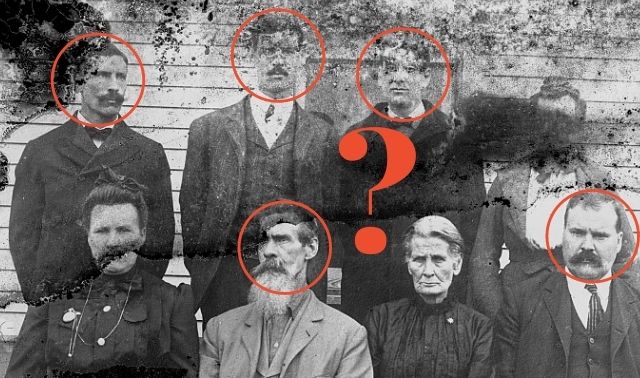“Many bags look alike. Please check your claim ticket.” This familiar message, posted on airport baggage claim belts throughout the world, reminds us how easy it is to confuse similar-looking items. Your bag may be the identical size, shape and color—even the same brand—as someone else’s. So it’s essential to spend a few moments to make sure you’ve got the right one before hauling it home.
The same concept applies to sorting through genealogical records of people with similar names, ages and localities. Simply picking up someone who looks right in a single record can lead to a trail of confusion. If only our ancestors came with claim tickets.
Some of the factors that make it hard to determine whether an individual in one record is the same individual in another record include:
- common names
- irregular and variant name spellings
- inconsistent ages and birthplaces in genealogical records
- lack of vital records
- county boundary changes
- migration to new areas
- lost or destroyed records
Female ancestors can be especially challenging to identify. Married women tend to show up in far fewer historical records than their husbands, brothers and fathers, and details about their lives may be hard to come by. Unknown maiden names, uncertain dates and places of birth, and the use of nicknames can complicate your efforts to determine whether “Mary Robinson” is or isn’t a different person from the “Polly Robeson” who’s named in separate records from the same place.
Fortunately, you can create your own set of ancestor IDs—ways to distinguish your relatives from others who look like them. Use these seven time-tested strategies to confirm you’re adding the right people to your family tree and avoid problematic and time-consuming mistakes.
1. Resist the Urge to Merge Similar People
The growing abundance of online family trees offers a tremendous resource for genealogists, but the quality and reliability of information varies greatly. While some trees connect names and facts to reliable sources, many others lack documentation. The same mistakes may be repeated as people merge trees or copy and paste data, so it’s crucial to understand how to evaluate and use what you find.
Online family trees come in two basic varieties: individual and collaborative. Individual trees start with one person, branching upward through his or her ancestors. These include the trees you’ll find at Ancestry.com, MyHeritage, and Findmypast.
Collaborative trees take a wiki-style approach, reflecting the combined submissions of multiple users. Anyone can add, remove or change information. Examples include the Family Tree at FamilySearch, in addition to WikiTree, WeRelate and Geni.
Regardless of the type, seasoned genealogists urge caution when approaching online trees. Look for sources and attached records to back up the events and relationships they claim. How does this compare with the research you’ve done? What can you find to verify the information? Just because something is found in 12 trees doesn’t mean it’s right. Both individual and collaborative trees may contain errors, omissions and redundancies.
Those trees are fertile ground for one thing, though: clues. They can prompt you to investigate theories you hadn’t thought of. Perhaps you didn’t consider that your ancestor could’ve been drafted for the Civil War, had a possible brother in Illinois, or might’ve married again. These hints can open your eyes to new databases and suggest other places and events to research. Dig further. If a record is available, examine it carefully before attaching it to your ancestor. If not, can you find some other record?
By navigating slowly, person by person and record by record, you’re much less likely to veer off onto the wrong path. You’ll also get to know your ancestors better, and pick up on small details that you would’ve overlooked by simply merging someone else’s tree with your own. Those details can make a big difference in picking out your relatives from the crowd.
2. Venture Beyond the Index
Published indexes to records, such as books listing all the births recorded over a span of years, are terrific leads to information. So are their online counterparts: databases without attached images. It’s exciting to flip to the back of a book, find your great-grandmother’s name, turn to the page and discover when she was born. It’s equally thrilling to type her name into a search engine and watch the results pop up.
But if you’re depending on the index or database alone, you’re missing the best part. An index or database entry merely indicates that a record exists. Unless the record itself was destroyed, it’s waiting to be found, and now you have the means to locate it. Don’t sell yourself short and risk making a mistake by merely entering the birth date in your family file or notes and moving on. Go get the prize.
You’ll usually find information about the records used to create an index in the front of a book. With a database, look for a section called “About” (Ancestry.com) or “How to Use This Collection” (FamilySearch). You might discover the records are available on another website or at a state archives.
Once you have the record in hand, extract every detail. You’ll probably find it contains more information than the index or database provided. A child’s birth record might state the father’s name and birthplace, mother’s maiden name and birthplace, their residence and the father’s occupation. Take note of these identifiers. How do they compare with what you’ve found in census and other records? A detail like the father’s occupation may seem insignificant at first, but could prove to be just the ticket for setting him apart from others with the same name. Checking original records also helps eliminate look-alikes. Remember, indexers may have struggled with poor handwriting, faded pages and unfamiliar names.
Say you find two Joseph Walkers in a marriage database. You obtain both marriage records, and discover one actually appears to be for Joseph Wilkins. Sure enough, there’s a Joseph Wilkins and a Joseph Walker in the census, too. Now you can set Wilkins aside and concentrate on the remaining Walker marriage with more confidence.
3. Create a Chart or Timeline
By now you might be wondering how to organize all this data you’ve been gathering. Rather than leave it swirling around in your head or buried in your files, compile it into a chart, spreadsheet or timeline. This gives you a quick, grab-and-go reference to use as you’re researching and drawing conclusions about your ancestor’s life.
Charts are flexible aids for analysis. You might simply make notes regarding the records you’ve found or zoom in on a specific problem. Many genealogists use charts to compare and contrast information from different sources. They’re especially helpful for determining if all the records collected actually pertain to the same person or not. A chart could compare a series of census records, a set of property deeds, city directory listings or any combination of records.
A timeline is a chart of events arranged in chronological order. To create a timeline, set up a table or spreadsheet with lots of rows and six columns:
- date
- event
- location
- names and ages of people in the record
- notes and comments
- source(s) of information
Begin filling in the events of your ancestor’s life—anchoring events like birth, marriage and death, as well as others like census enumerations, land purchases, births of children, city directory entries and naturalization. Before long, you’ll have a concise and orderly synopsis of your work.
Timelines can be as simple or complex as you like. For greater detail, make entries about parents, siblings and in-laws. You can also add pertinent historical events such as wars, floods, waves of immigration or the construction of a railroad through town. These things can help put your ancestors into historical context.
Once your timeline’s finished, you’ll be able to see at a glance where your ancestor lived at a given time, what he was doing, who was with him and anything else that struck you as noteworthy. Those between-the-census years will begin to take shape. You might notice patterns, identify gaps or reveal conflicting information you need to resolve.
As your ancestor comes into clearer focus, you’re more likely to see clues in circumstantial evidence that can help answer questions about him. And you’ll be much less prone to confuse him with someone else.
4. Map Out Your Ancestor’s Town
Visualizing the places your ancestor called home is a powerful tool in establishing his identity. In addition to showing where he lived, maps can illuminate how he lived. Was the area along a river used for transportation? Was it near a fort or on the outskirts of a city? Did mountains or other obstacles form a natural barrier to travel?
Boundary changes over time affected which courthouse your ancestor went to and where you’ll find records today. City, county, state and territorial boundaries were in constant flux throughout much of the 18th and 19th centuries. Fortunately, these changes have been well documented. The Family Tree Historical Maps Book (Family Tree Books) is a handy resource for genealogists that shows changes in US states over time. Two websites that portray shifting state and county boundaries are the Newberry Library’s Atlas of Historical County Boundaries and Maps of US.
Just when you’ve become comfortable with one locality, you might find your family members uprooted and migrated somewhere else. Pinpoint the new place on a map to see what kind of journey they undertook. Two towns in different states may be hundreds of miles apart—or sit on opposite banks of a river. Was the climate and terrain in the new location similar to that of the old one, or did your ancestor have to adapt to an entirely different environment?
Maps not only show you distance and direction, but also suggest possible routes and methods of travel. Consider both when and where they moved. By studying historic roads, canals and railways in conjunction with maps, it’s possible to get an idea of how your ancestor got from Point A to Point B.
Modern road maps showing political boundaries are a good place to start, but don’t stop there. Look for historical maps and atlases, as well as topographical or geological maps, railroad maps, township maps, Sanborn insurance maps, surveys and town plats. Local maps and atlases might even identify your ancestor’s land by name. To find maps, try the David Rumsey Map Collection or Google the place name along with the keyword map.
5. Research Friends, Associates, Neighbors and Extended Family
Cell phone providers know their customers rely on networks of friends and family. Our ancestors didn’t have cell phones, of course, but their networks played an important role in their lives. Friends, relatives, neighbors, church members, business associates and shopkeepers formed a community people lived within and relied upon. Exploring this community is one of the best ways to solidify your ancestor’s identity.
Certified genealogist Elizabeth Shown Mills, author of references such as Evidence Explained, 3rd edition (Genealogical Publishing Co.), coined the phrase “FAN club”—friends, associates and neighbors—to illustrate this concept. Others call it cluster research. By any term, it’s a valuable strategy for success, especially in dealing with common names, migration mix-ups and brick wall problems.
Start by making a list or spreadsheet of names other than the primary person found in records you’ve obtained. Who witnessed your ancestors’ marriages, naturalizations, deeds and wills? Baptism records might give the names of sponsors or godparents, typically relatives or close friends. Who administered his estate, posted bonds or bought things at his estate sale? Identify all the in-laws you can, particularly husbands of his sisters and daughters. Now you have a core group of associates to add to his profile.
Move to your ancestor’s first census record. Look at the households at least a page before and after his (the tougher the research problem, the more names you’ll want to gather). Do the same for other census records. What similarities and overlaps do you see?
Once you’ve compiled your list, use it to propel your search. If your ancestor’s name is common, try researching an associate’s unusual name. If you’re trying to track your kin back to a previous location but aren’t sure you’ve found the right one, look for his friends there. The old saying “A man is known by the company he keeps” is good to bear in mind. Your ancestor’s migration path may have followed—or paved the way for—that of his neighbors. By tagging and embracing others in his network, you increase your chances of a positive ID.
6. Avoid Making Assumptions
As you’re searching for information about your ancestor, it’s natural to make some assumptions about her. Maybe you found her in the census at 6 years old and assume she was born in the same vicinity. Sometimes these assumptions are helpful because they can point you to particular records. But in many cases, assumptions box you in to a narrow set of options. What if her family moved to that place when she was 2?
Consider also that any record, even one created at the time of the event, might be wrong. People fudged their ages on marriage licenses, passenger lists and military enlistments. They guessed about things they didn’t know, such as where a parent was born. They put the names of adoptive or stepparents in place of biological parents. They filled out family record pages in Bibles based on memory and passed-down stories.
In short, no record is guaranteed to be error-free or complete. Tread carefully when making an assumption, especially one based on a single source. Say you’ve found your great-grandfather in the 1880 census with his wife and three children. Does that mean she was the mother of all the children? Not necessarily. The census only reports their relationship to the head of the household. You might develop a theory that the couple married before the first child was born, but you can’t say for sure yet.
There’s a fine line between an assumption and a theory, but it’s an important one for genealogists to draw. An assumption restricts your thinking with preconceived notions. A theory focuses your thinking in a probable direction, but allows you to remain open to other possibilities. To successfully identify your ancestor, shed your assumptions and work your theories. Which brings us to the final strategy.
7. Consider Other Theories
Tough cases of ancestor identity verification often come down to two or three possibilities. Some common examples include:
- Which of the three men in the county who are named Thomas Williams is your ancestor?
- Was Robert Evans or Isaac Evans the father of Sarah Evans?
- Do all the records you’ve found belong to the same person, or were there two Nicholas Millers in the same town?
If the steps outlined above haven’t given you a clear answer, your next recourse is a process of elimination. Research each possible person extensively and try to rule one out. Perhaps one Thomas Williams proves to be far too young to be the one in your family tree. Another was born in Ireland, whereas your ancestor was German. The last man standing is your likely target.
Writing is another powerful tool for distilling your thoughts. Write out your theory as though defending it. Itemize the evidence that supports your conclusion and how you reached it, noting your sources. Experienced genealogists call this a proof summary. If you found contradictory information, also explain how you resolved it.
Now take a look at your summary with a critical eye. If you have a genealogy buddy or belong to a local society, have someone else read it, too. Where are the holes? Could someone shoot down your conclusion? Have you really searched for all types of evidence, even newspapers and local records that haven’t been microfilmed? Consider hiring a researcher or contacting a society where your ancestor lived to obtain these elusive resources.
Claiming the right ancestors out of a jumbled pile of choices is a skill anyone can develop. Don’t just grab the first one you see who seems to fit. By using these seven strategies, you can be certain of making accurate identities, leading to more research success and a flourishing family tree.
Related Reads
A version of this article appeared in the January/February 2016 Family Tree Magazine. Last updated: December 2024
FamilyTreeMagazine.com is a participant in affiliate programs through Genealogical Publishing Co. It provides a means for this site to earn advertising fees, by advertising and linking to affiliated websites.










